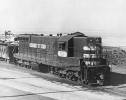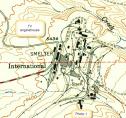
| Home | Open Account | Help | 394 users online |
|
Member Login
Discussion
Media SharingHostingLibrarySite Info |
Nostalgia & History > Tooele Valley and KennecottDate: 09/23/16 13:39 Tooele Valley and Kennecott Author: donstrack Here are some recent scans from Dave England's collection. They are from 8x10 prints, that were very badly curled, and without any data as to photographer, date or location. Dave says they are not his photos, nor does he recall where they came from. About possible dates, one indicator would be that Tooele Valley 2-8-0 no. 11 was retired in 1963, and the Tooele Valley diesel no. 100 was purchased new in 1955.
Don Strack    Date: 09/23/16 13:52 Re: Tooele Valley and Kennecott Author: refarkas Beautiful images. My favorite is the first one which captures a scene that must have rarely been photographed. What a treasure this image is.
Bob Date: 09/23/16 14:05 Re: Tooele Valley and Kennecott Author: mcfflyer Wow. Cool photos. Just where was that plant located? Was it further up the hill from the TV enginehouse?
Lee Hower - Sacramento Date: 09/23/16 14:14 Re: Tooele Valley and Kennecott Author: callum_out Date: 09/23/16 14:19 Re: Tooele Valley and Kennecott Author: donstrack Lee, the Tooele Valley enginehouse was on site at the International smelter, east of Tooele. The first photo shows the part of the smelter on the site's east side. The enginehouse was on the west side. The smelter was built in 1910 and was closed in 1972. Tooele Valley was used to move the pieces and parts of the smelter as it was demolished during 1972-1975. It was then used for inbound shipments of materials for the new Carr Fork undergound mine, about a mile east of the smelter site. The new mine started production in September 1979. The mine shut down in late 1982 because of Anaconda's financial woes, and the railroad stopped running. The railroad's last day of operation was October 28, 1982.
[Edit: Here is a portion from a 1952 USGS map, showing the area around the International smelter.] Don Strack Edited 3 time(s). Last edit at 09/27/16 19:20 by donstrack.  Date: 09/23/16 14:31 Re: Tooele Valley and Kennecott Author: march_hare Actually, Carr Fork's closure was a cause of Anaconda's woes, not a result.
The mine was poorly designed. To make a long story short, the ore was very hard and the country rock which hosted it was very soft. The vertical passes between mine levels (short tunnels which allowed ore to drop by gravity from one level down to another for haulage out of the mine) eroded so rapidly that the blocks of ore would jam up and not allow the ore to pass. Attempts to clear up the jams were unsuccessful, and at least one employee died while trying to break up a jam. Eventually, with copper prices in the toilet worldwide, they gave up. Date: 09/23/16 14:56 Re: Tooele Valley and Kennecott Author: donstrack march_hare Wrote:
------------------------------------------------------- > Actually, Carr Fork's closure was a cause of > Anaconda's woes, not a result. > > The mine was poorly designed. To make a long > story short, the ore was very hard and the country > rock which hosted it was very soft. The > vertical passes between mine levels (short tunnels > which allowed ore to drop by gravity from one > level down to another for haulage out of the mine) > eroded so rapidly that the blocks of ore would jam > up and not allow the ore to pass. > > Attempts to clear up the jams were unsuccessful, > and at least one employee died while trying to > break up a jam. Eventually, with copper prices > in the toilet worldwide, they gave up. > The mine at Carr Fork was just one of numerous problems. Anaconda's woes came from the loss of their mine in Chile, as well as parent company Arco's lack of interest in Anconda's operations. Arco was flush with cash from all that Alaska oil, and needed some place to put it. They never did figure out that doing well in one natural resource (oil) does not translate well to another natural resource (hardrock copper mining). Recently, I talked to the (now retired) last chief geologist for Arco/Anaconda. He talked about the problems at the Carr Fork mine, and how dangerous it was. Literally, a black hole into which they poured money. My interest was actually why, after buying National Tunnel and Mines in 1948, Anaconda shut down all Carr Fork operations. They kept exploring, drilling lots of test holes to see where the ore body boundaries were. Finally in the mid 1970s, they decided to develop an all-new Carr Fork mine, in crappy rock. They tried a new mining method called caved stoping "that didn't work out." Now that's an understatement. Don Strack Date: 09/23/16 16:53 Re: Tooele Valley and Kennecott Author: march_hare Sounds like you got the story just about right. None of the 1980 era acquisitions of mining companies by oil and gas companies worked out in the end.
Posted from iPhone Date: 09/23/16 19:34 Re: Tooele Valley and Kennecott Author: wag216 I think that the 3rd photo, shows a 1957 Chevy (maybe) wag216
Date: 09/24/16 14:42 Re: Tooele Valley and Kennecott Author: rrpreservation Where is the TV museum? It'd be fun to check it out sometime!
Date: 09/24/16 17:42 Re: Tooele Valley and Kennecott Author: callum_out Date: 09/27/16 18:14 Re: Tooele Valley and Kennecott Author: ldeppe1 I would like to make a few comments. My comments are based on my having worked at the Tooele Smelter while going to college and my father having worked at the plant for 47 years. I have also been a member of the board for the
museum since it inceiption. 1. The Tooele Valley Railway never carried any of the product mined at Carr Fork. The materials were tranported by large dump trucks to a load-out in Erda where the contents were dumped into rail cars. During the planning for the Carr Fork project, a proposal was made to abandon the Tooele Valley right-of-way through the middle of Tooele City and lay track along the base of the Oquirrh Mountains so that the Tooele Valley would meet the Union Pacific without having to travel through the middle of Tooele City. The decision was made to use trucks instead. 2. The first picture showing Number 11 in the yard at the smelter shows a general service gondola with outside bracing coupled to the engine. This would suggest that the car was older and thus the picture could be older than it might seem. 3. Number 11 was generally run twice each year when the wheels of engine 100 had to be turned. The 100 was transported to the Union Pacific Diesel shop in Salt Lake City for this procedure. The photo of Number 11 and Number 100 was taken at Warner depot west of Tooele City. I remember this very well because I spent the first twelve years of my life in a house just across the street from the Tooele Valley line and both engines had passed our house that day. According to Don Lee, one of the firemen for the Tooele Valley, the diesel locomotive would not start. 4. My experience at the smelter actually helped me get a job. I am a CPA and was interviewed by one of the then-big-eight accounting firms. They asked me if I had ever had any experience in the mining industry. I told them that I had and I was hired by the firm. I audited two mining operations: the Ontario mine in Park City and the Blackbird mine in Salmon, Idaho. 5. I helped move Number 11 from the Tooele City Park when the station and property were transferred to Tooele City. We went up to a siding east of 7th Street. The siding had been cut free from the main line. The Tooele Army Depot was kind enough to provide a crane which was used to pick up the siding and set it on two flat cars (also provided by the Depot). Everything seemed fine except for one thing: Some of the ties at the end of the siding had fallen off. The locomotive had been set on a pedestal in the Park in 1964. The rails of the siding were removed from the flat cars and attached to the rails in the pedestal. The engine was pushed and pulled to move it off the pedestal into the street where the Tooele Valley tracks ran. Everything seemed to be going fine until the locomotive reached the portion of the old siding without any ties. At that point, the rails spead outward and the engine and tender ended up sunk in the asphalt of Vine Street. The Tooele Valley's second diesel locomotive, No. 104, an SW900, was then attached to the coupler of the tender. When the engineer opened the throttle, the locomotive stopped due to a governor that prevented wheels from slipping on . the rails. A tractor (also provided by Tooele Army Depot) was tied to the rear of the 104 and the old steam engine was finally removed from the asphalt. I hope you find these comments interesting. Larry A. Deppe Date: 09/27/16 19:19 Re: Tooele Valley and Kennecott Author: donstrack Thank you Larry Deppe. Personal experience and observation is the best resource.
Don Strack Date: 09/28/16 11:06 Re: Tooele Valley and Kennecott Author: ldeppe1 Don,
Thank you for all you do to educate people regarding the importance of railroading. Larry |